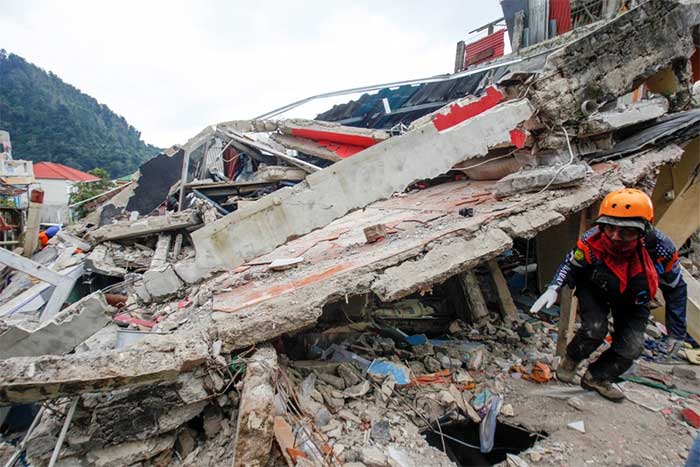The earthquake that struck Indonesia on November 21 is considered to have a moderate intensity and a shallow epicenter; however, it caused significant damage due to various factors.
A magnitude 5.6 earthquake resulted in over 260 fatalities and hundreds of injuries on the main island of Java (Indonesia), according to AP.
Rescue teams continued to pull bodies from the rubble on the morning of November 22 in Cianjur, the area most heavily affected. This city is located in West Java, the most populous province of the country, approximately 217 km south of the capital, Jakarta. Meanwhile, many individuals remain missing.
This earthquake’s intensity is usually thought to cause only minor damage to buildings and infrastructure. However, experts believe that the proximity to fault lines, the earthquake’s shallow depth, and the characteristics of the infrastructure all contributed to the damage.

A rescue worker navigates through the rubble of collapsed buildings in Indonesia. (Photo: Reuters).
At a local hospital, the number of patients overwhelmed the facility, with many injured individuals lying on the floor or under makeshift tents. On the night of November 21, victims were treated by candlelight due to widespread power outages in the area.
Is the earthquake in Indonesia considered “strong”?
The United States Geological Survey reported that the earthquake on the afternoon of November 21 had a magnitude of 5.6 and occurred at a depth of 10 km. Therefore, it is classified as a shallow earthquake, as the seismic energy did not travel far before impacting people and buildings, according to the Washington Post.
Earthquakes of this magnitude typically do not cause widespread damage to sturdy infrastructure. However, the agency pointed out that the damage also depends on other factors, such as the distance from the earthquake, the type of soil in the area, and more.
Earthquakes can occur at any time and at varying depths. According to Babek Hejrani, a researcher at the Australian National University, they only become “devastating” when they occur near infrastructure or populated areas.
She noted that the closer one is to the earthquake’s epicenter, the greater its destructive power. The epicenter of the earthquake on November 21 was near the densely populated city of Cianjur, ABC reported.
Why did this earthquake cause significant damage?
Experts indicated that the proximity to fault lines, the earthquake’s depth, and the fact that buildings were not designed to withstand earthquakes are the factors that caused this damage.
“Although the earthquake was of moderate scale, it occurred near the surface and inland, close to where people live. Its energy was still large enough to cause significant shaking, leading to damage,” said Gayatri Marliyani, an associate professor of geology at Gadjah Mada University (Yogyakarta, Indonesia).
Additionally, Marliyani noted that the most heavily affected area is near several known fault lines.
A fault line is a long crack in the Earth’s crust. When an earthquake occurs above one of these fault lines, the rock on one side of the fault is displaced relative to the other side.
“This area seems to have more fault lines inland compared to other places in Java,” Marliyani said.
Furthermore, according to her assessment, while some fault lines are well-known in the area, others that are still active have not been thoroughly studied.
Danny Hilman Natawidjaja, a seismic geologist at the Geological Technology Research Center of the Indonesian Institute of Sciences, stated that many buildings in this area were also not designed to be earthquake-resistant, further contributing to the damage.
Do earthquakes like this frequently occur in Indonesia?
This country, with a population of over 270 million, regularly experiences earthquakes, volcanic eruptions, and tsunamis due to its location on the “Ring of Fire”. This region spans approximately 40,000 km and is home to the majority of the world’s earthquakes.
Many earthquakes in Indonesia are of small magnitude and cause little to no damage. However, the country has also witnessed deadly earthquakes.
In 2004, a magnitude 9.1 earthquake off the coast of Sumatra triggered a tsunami across the Indian Ocean, resulting in 226,000 fatalities—over half of whom were Indonesians.

















































